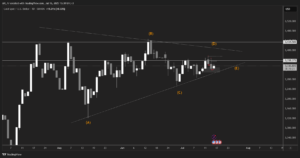Gold ended last week sharply lower, erasing previous gains and sending analysts back to two reasons for the decline: China’s halt to aggressive gold buying in May and strong labor market data that changed interest rate expectations from the Fed.
Strong labor market data has convinced investors that the Fed will keep interest rates high for longer than expected. These developments have raised questions about the value of gold without China’s support. The weekly chart suggests that the near-term value of gold could be between $2217.22 and $2130.29, suggesting potential losses of between $75 and $150. XAU/USD settled last week at $2294.015, down $33.185 or -1.43%.
China’s Impact on Gold Prices
On Friday, Reuters reported that the People’s Bank of China (PBoC) halted gold purchases for its reserves in May after increasing gold reserves for 18 consecutive months. Reuters said: “China held 72.80 million troy ounces of gold at the end of May, unchanged from the end of April, according to the data.” With the immediate reaction to this headline, XAU/USD fell below $2,340, erasing much of its weekly gains.
For months, gold price gains were attributed to aggressive buying by central banks, particularly China. However, these gains stalled in May, leading to speculation about whether central banks are still buying, have stopped, or are taking profits. Unlike prominent investors who openly discuss their deals, central banks operate in silence, leaving markets guessing their next moves. This ambiguity about central bank movements has turned investors from long-term optimists to short-term traders, adding to market volatility.
China’s halt to gold buying after 18 months has significant implications. Central banks often follow herd theory; if China stops buying, others may follow. The possibility that China could start selling could add further pressure to gold prices. Traders are watching the charts closely for any signs of this change before it becomes public knowledge.
Strength of the US Labor Market
Gold bulls also have to deal with higher interest rates for longer due to the strength of the US labor market. The Labor Department’s report showed that nonfarm payrolls rose by 272,000 in May, exceeding expectations of 185,000. The strong labor market, with rising wages and increasing consumer spending, suggests that inflation may not come down quickly, forcing the Fed to keep interest rates high. This situation increases the opportunity cost of holding non-yielding bullion, adding to negative sentiment in the gold market.
The Fed is not expected to make any interest rate changes at its upcoming monetary policy meeting, but the focus will be on Fed Chairman Jerome Powell’s comments and changes to the economic outlook from policymakers. US inflation data is also scheduled for release on Wednesday. The dollar rose to its highest in over a week against its rivals, while the benchmark 10-year US Treasury yield rose to its highest level since June 3.
Gold and the Dollar Now
Gold futures are now down 0.75% to $2307 an ounce.
While spot gold is down about 0.15% to $2290 an ounce.
On the other hand, the dollar index is flat at 104.890 points.
Other Metals
Silver rose 0.9% in spot trading to $29.43 an ounce, platinum gained 0.8% to $971.10 and palladium rose 1.1% to $922.38.
Key Events to Watch This Week
The Fed meets as key US inflation data is released. The Bank of Japan also meets, and economic data from the UK will be released, which the Bank of England will rely on in its decision on whether to cut interest rates. Here’s a look at what’s happening in the markets next week:
Federal Reserve Decision
With widespread expectations that the Federal Reserve will keep interest rates unchanged at the end of its two-day meeting next Wednesday, market watchers are instead focusing on the number of cuts policymakers will signal for the rest of 2024.
The updated dot plot is likely to show two 25-basis-point cuts this year, after showing three cuts in March. Friday’s jobs data, which showed accelerating job and wage growth in May despite a rising unemployment rate, has caused market expectations for interest rate cuts this year to be pushed back, with the first rate cut now expected in September.
Recent comments from Fed officials have indicated that they are in no hurry to cut rates as inflation remains sticky and growth expectations remain strong. Inflation has cooled after the sharp rate hikes that began in 2022, but it has not yet fallen back to the 2% target.
May Inflation Data
May inflation figures are due out just hours before the Fed’s statement on Wednesday. More signs of easing inflation could boost hopes for rate cuts, especially in the face of signs of economic weakness.
Wall Street will be closely watching what the inflation data will show, supported by the easing of inflation. Traders continue to price in some monetary easing this year, with some faint hope of a rate cut in July. Bad inflation data could spook investors and bring back recession fears that have been dormant for several months. There is no doubt that the data could ignite markets ahead of the press conference to be held by Fed Chairman Jerome Powell after the meeting.
Wall Street
Wall Street will be closely watching the inflation data and the Fed meeting on Wednesday for clues as to whether the hopes that have driven stocks to record highs are still justified.
This year’s rally has seen the S&P 500 rise more than 12% year-to-date, amid expectations that the Fed can tame inflation without hurting growth. However, recent economic data has shown mixed signals: Friday’s jobs report was much stronger than expected, while earlier reports showed a slowing manufacturing sector and a revised first-quarter growth rate that came in below expectations.
Bank of Japan
Bank of Japan Governor Kazuo Ueda has already hinted at some form of scaling back the central bank’s long-running QE program when the Bank of Japan concludes its two-day meeting on Friday.
He said on Thursday that it would be appropriate to reduce its still-massive bond purchases as the BOJ exits years of stimulus, stressing that policymakers would move “cautiously” on raising rates after the first hike since 2007 in March.
Mizuho Financial Group sees a good chance of cutting monthly purchases by ¥1 trillion ($6.4 billion) to around ¥5 trillion per month, something the bond market may be able to take in stride. Whether that would support the battered yen is a separate issue, with the BOJ and the government worried that a weak currency could derail their hoped-for cycle of moderate inflation and steady wage gains.
Disclaimer: This article is not investment advice or an investment recommendation and should not be considered as such. The information above is not an invitation to trade and it does not guarantee or predict future performance. The investor is solely responsible for the risk of their decisions. The analysis and commentary presented do not include any consideration of your personal investment objectives, financial circumstances, or needs.





